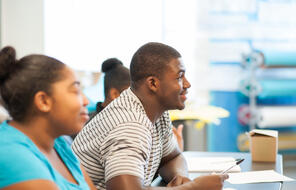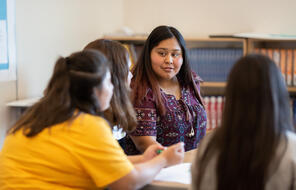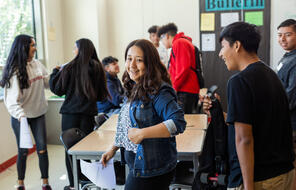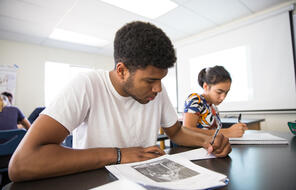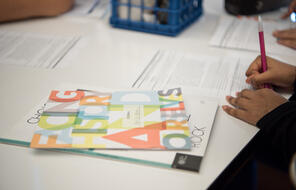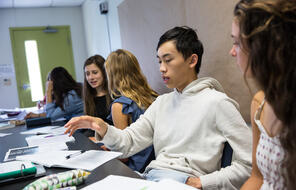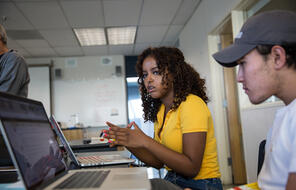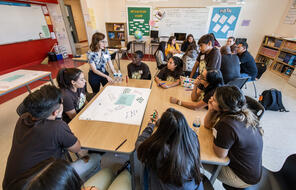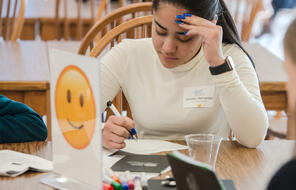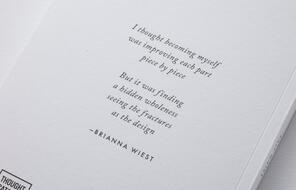Being Jewish in the United States
Judaism, a religious faith that began in the Middle East over 3,500 years ago, is the world’s oldest monotheistic religion. Today, more than 14 million Jews live in dozens of countries around the world, the majority in Israel and the United States. (In the United States, there were about 7 million Jews, comprising about 2% of the population, in 2016.) 1
There are several branches within Judaism—including but not limited to Reform, Orthodox, and Conservative—in the United States and elsewhere. According to scholar Stephen Prothero, “The simplest way to describe these three groups [Reform, Orthodox, and Conservative] is to say that each focuses on one key element in Judaism: the Reform on ethics, the Orthodox on law, and the Conservative on tradition.” 2 But these simple descriptions do not fully express the richness of the various branches of Judaism or the ideas and beliefs that unite them. A Jewish house of worship is called a synagogue, and the most important religious text in Judaism is the Torah. The Torah includes five books that also appear as the first five books in the Christian Old Testament.
Like the members of any religion or culture, Jews think about and express their identities in a variety of ways, prioritizing their Jewish identity differently within the mix of other factors that make them who they are. In the following three reflections, Rebecca, then age 17, Sara, then age 18, and Angela, an adult, explain the influence that Judaism has on their lives. These are only three examples from the numerous ways that Jews around the world relate to the faith and culture of Judaism. Rebecca writes:
[I]n the Torah, there are 613 commandments. They involve everything from how you treat other people, to Jewish holidays and how we observe them, and the Sabbath, which is every week, and how we observe that. It’s like a guide how to live.
There are also a lot of dietary laws. The dietary laws say we can only eat certain kinds of meat that are killed and prepared in a certain way. We can’t eat meat at nonkosher restaurants. My parents like to remind me of this funny story. One time when I was two, we were driving past a Burger King. I saw the sign, and I yelled out, “That sign says Burger King. No burgers for Jewish people.” I picked up on those observances. It was always something that was part of me. I recognized that it was important.
We set the Sabbath aside as a day of rest because God rested on the seventh day after creating the world. Because of this, there are lots of rules for things you can and can’t do . . . It’s supposed to be a day of rest—you’re not supposed to do any type of work, or watch television, use the computer, use electricity, any of that stuff . . . For me it’s very spiritual. It really separates the day out from the rest of the week.
I spend a lot of time with my family—from Friday night at sundown until Saturday night. I go to prayers at my synagogue in the morning and sometimes in the afternoon. It’s just a really spiritual experience. It makes it more of an important day . . .
I haven’t gone to see a movie on a Saturday or Friday night ever.
It’s weird being in a public high school because you’re faced with being in a school where there’s lots of activities on Friday nights and things to miss out on. Like all the school plays are on Friday nights. I have to give up trying out for school plays. And sports—I used to play softball. But there are games every Saturday, so I couldn’t play those.
A lot of people look at it like, “How can you give up all of this stuff because of your religion?” It’s just a matter of how you look at it. You can look at it as being a burden—that you have these religious obligations, so you’re not able to do your school activities. But I look at it as a more positive experience. It’s something that I choose to do. 3
Sara, age 18, feels differently about the rituals and worship practices of Judaism:
I feel really connected with my Jewish community, but a little less connected to the observance factor of my religion. I don’t keep kosher. I don’t really feel that that’s necessary. When I was little, my whole family would sit down every Friday night and light the Shabbat candles and say the blessings. We don’t do that anymore. Now it’s like, “It’s Friday night. I’m going to go out with my friends.”
I don’t like organized prayer. Every once in a while I go to services, but I appreciate it a lot more when I do my own thing and say my own prayers . . .
When I was younger, I never really thought I was different ’cause I was Jewish. It didn’t occur to me until high school when I started getting really involved with stuff. It’s kind of weird when I really think about it. It’s like I’m just like everyone else, except there’s that little part of me that’s going to be Jewish forever, and that makes me different. 4
Born in Seoul, Korea, to a Korean Buddhist mother and an American Jewish father, Angela explains how she grew to understand herself within the diversity of Jewish life around the world and throughout history:
Growing up, I knew my family was atypical, yet we were made to feel quite at home in our synagogue and community . . .
As a child, I believed that my sister and I were the “only ones” in the Jewish community—the only ones with Asian faces, the only ones whose family trees didn’t have roots in Eastern Europe, the only ones with kimchee on the seder plate. But as I grew older, I began to see myself reflected in the Jewish community. I was the only multiracial Jew at my Jewish summer camp in 1985; when I was a song-leader there a decade later, there were a dozen. I have met hundreds of people in multiracial Jewish families in the Northeast through the Multiracial Jewish Network. Social scientist Gary Tobin numbers interracial Jewish families in the hundreds of thousands in North America.
As I learned more about Jewish history and culture, I found it very powerful to learn that being of mixed race in the Jewish community was not just a modern phenomenon. We were a mixed multitude when we left Egypt and entered Israel, and the Hebrews continued to acquire different cultures and races throughout our Diaspora history. Walking through the streets of modern-day Israel, one sees the multicolored faces of Ethiopian, Russian, Yemenite, Iraqi, Moroccan, Polish, and countless other races of Jews—many facial particularities, but all Jewish . . .
What does it mean to be a “normal” Jewish family today? As we learn each other’s stories we hear the challenges and joys of reconciling our sometimes competing identities of being Jewish while also feminist, Arab, gay, African-American, or Korean. We were a mixed multitude in ancient times, and we still are . . .
Connection Questions
- Create identity Charts for Rebecca, Sara, and Angela in your journal. Use evidence from the text to support your ideas about each young woman’s identity. What do they have in common? What differences do you notice?
- What role does religious belief and practice seem to play in the identities of Rebecca, Sara, and Angela?
- How do the information and reflections in this reading connect to, extend, or challenge your understanding of what it means to be Jewish? What new questions does this reading raise for you?
- 1Brandeis University, "American Jewish Population Project," Steinhardt Social Research Institute, accessed May 30, 2017.
- 2Stephen Prothero, God Is Not One: The Eight Rival Religions That Run the World (New York: HarperOne, 2010), 267.
- 3“How Can You Give Up All of This Stuff Because of Your Religion?,” in Pearl Gaskins, I Believe In...: Christian, Jewish, and Muslim Young People Speak About Their Faith (Chicago: Cricket Books, 2004), 58–59. Reproduced by permission from Carus Publishing Company.
- 4 “I Wear Two Stars of David,” in Gaskins, I Believe In..., 33. Reproduced by permission from Carus Publishing Company.
How to Cite This Reading
Facing History & Ourselves, “Being Jewish in the United States”, last updated March 18, 2018.

